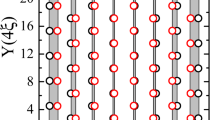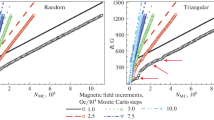Abstract
Current-voltage characteristics have been calculated for a high-temperature superconductor containing triangular and square periodic arrays of pinning centers with various disorder rates. Non-monotonic dependences of critical current density on the disorder rate have been obtained for the triangular lattice, showing that a perfectly ordered lattice provides smaller critical currents than that with minor distortions, especially at high magnetic fields. For the square lattice, the critical current was mostly declining, with minor peaks at small disorder rates. A thorough analysis of the vortex dynamics has been done, showing the differences in the way vortices move through the disordered lattice and how their paths affect the critical current density.


















Similar content being viewed by others
Data Availability
Data sets generated during the current study are available from the corresponding author upon reasonable request.
References
Gao, Y., Wang, W., Wang, X., Ye, H., Zhang, Y., Zeng, Y., Huang, Z., Zhou, Q., Liu, X., Zhu, Y., et al.: IEEE Trans. Appl. Supercond. 30(4), 1 (2020)
Zhu, X., Cheng, M.: IEEE Access 7, 51129 (2019)
Anand, A., Gour, A.S., Datta, T.S., Rao, V.V.: J. Supercond. Novel Magn. pp. 1–11 (2023)
Tsukamoto, A., Adachi, S., Oshikubo, Y., Tanabe, K.: IEEE Trans. Appl. Supercond. 23(3), 1600304 (2012)
Charaev, I., Bandurin, D., Bollinger, A., Phinney, I., Drozdov, I., Colangelo, M., Butters, B., Taniguchi, T., Watanabe, K., He, X., et al.: Nat. Nanotechnol. 18(4), 343 (2023)
Lang, W., Richter, H., Marksteiner, M., Siraj, K., Bodea, M., Pedarnig, J., Grigoropoulos, C., Bauerle, D., Hasenfuss, C., Palmetshofer, L., et al.: Int. J. Nanotechnol. 6(7–8), 704 (2009)
Swiecicki, I., Ulysse, C., Wolf, T., Bernard, R., Bergeal, N., Briatico, J., Faini, G., Lesueur, J., Villegas, J.E.: Phys. Rev. B 85(22), 224502 (2012)
Gutfreund, A., Matsuki, H., Plastovets, V., Noah, A., Gorzawski, L., Fridman, N., Yang, G., Buzdin, A., Millo, O., Robinson, J.W., et al.: Nat. Commun. 14(1), 1630 (2023)
Trastoy, J., Rouco, V., Ulysse, C., Bernard, R., Palau, A., Puig, T., Faini, G., Lesueur, J., Briatico, J., Villegas, J.: New J. Phys. 15(10), 103022 (2013)
Trastoy, J., Rouco, V., Ulysse, C., Bernard, R., Faini, G., Lesueur, J., Briatico, J., Villegas, J.: Phys. C Supercond. Appl. 506, 195 (2014)
Mletschnig, K.L., Lang, W.: Microelectron. Eng. 215, 110982 (2019)
Haag, L.T., Zechner, G., Lang, W., Dosmailov, M., Bodea, M.A., Pedarnig, J.D.: Phys. C Supercond. Appl. 503, 75 (2014)
Zechner, G., Jausner, F., Haag, L., Lang, W., Dosmailov, M., Bodea, M., Pedarnig, J.: Phys. Rev. Appl. 8(1), 014021 (2017)
Zechner, G., Mletschnig, K.L., Lang, W., Dosmailov, M., Bodea, M.A., Pedarnig, J.D.: Supercond. Sci. Technol. 31(4), 044002 (2018)
Aichner, B., Müller, B., Karrer, M., Misko, V.R., Limberger, F., Mletschnig, K.L., Dosmailov, M., Pedarnig, J.D., Nori, F., Kleiner, R., et al.: ACS Appl. Nano Mater. 2(8), 5108 (2019)
Backmeister, L., Aichner, B., Karrer, M., Wurster, K., Kleiner, R., Goldobin, E., Koelle, D., Lang, W.: Nanomaterials 12(19), 3491 (2022)
Aichner, B., Backmeister, L., Karrer, M., Wurster, K., Kleiner, R., Goldobin, E., Koelle, D., Lang, W.: Condens. Matter 8(2), 32 (2023)
Trastoy, J., Ulysse, C., Bernard, R., Malnou, M., Bergeal, N., Lesueur, J., Briatico, J., Villegas, J.E.: Phys. Rev. Appl. 4(5), 054003 (2015)
Paturi, P., Malmivirta, M., Hynninen, T., Huhtinen, H.: J. Phys. Condens. Matter 30(31), 315902 (2018)
Kato, M.: J. Phys. Conf. Ser. 2323(1), 012014 (2022)
Sørensen, M.P., Pedersen, N.F., Ögren, M.: Phys. C Supercond. Appl. 533, 40 (2017)
De Lascio, E.R., Cornejo, D.R.: Phys. C Supercond. Appl. 546, 11 (2018)
Lawrence, W.E., Doniach, S.: p. 361 (1971)
Kashurnikov, V.A., Maksimova, A.N., Moroz, A.N., Rudnev, I.A.: Supercond. Sci. Technol. 31(11), 115003 (2018)
Kashurnikov, V., Maksimova, A., Rudnev, I., Odintsov, D.: Phys. C Supercond. Appl. 528, 17 (2016)
Maksimova, A.N., Kashurnikov, V.A., Moroz, A.N., Rudnev, I.: Phys. Solid State 63, 64 (2021)
Moroz, A.N., Maksimova, A.N., Kashurnikov, V.A., Rudnev, I.A.: IEEE Trans. Appl. Supercond. 28(4), 1 (2018)
Kashurnikov, V.A., Maksimova, A.N., Rudnev, I.A., Odintsov, D.S.: J. Phys. Conf. Ser. 1238(1), 012016 (2019)
Moroz, A., Kashurnikov, V., Rudnev, I., Maksimova, A.: J. Phys. Condens. Matter 33(14), 145902 (2021)
Funding
This work was supported by a grant from the Russian Science Foundation No. 23-19-00394, https://rscf.ru/project/23-19-00394/.
Author information
Authors and Affiliations
Corresponding author
Ethics declarations
Conflict of Interest
The authors declare no competing interests.
Additional information
Publisher's Note
Springer Nature remains neutral with regard to jurisdictional claims in published maps and institutional affiliations.
Appendix
Appendix
The terms constituting Eq. (1) are described below. The self-energy of a solitary vortex can be written as:
where \(U_0 = \delta \left( \Phi _0 / (4\pi \lambda )\right) ^2\) is the characteristic energy scale of the vortex system, \(\Phi _0 = 2.07 \cdot 10^{-7}\ \mathrm {G\ cm^{2}}\) is the magnetic flux quantum and \(\delta\) is the thickness of the superconducting layer.
The vortex-vortex (or antivortex-antivortex) interaction energy has the following form:
where \(\textrm{K}_0\) is the Macdonald function (or the modified Bessel function of the second kind) and \(r_{ij}\) is the distance between the centers of interacting vortices. The same expression can be used for the interaction of vortices of opposing signs with one another, only in that case, a minus sign appears, since oppositely-directed circular currents attract each other.
The same potential can be used for the interaction of vortices with the rigid sample boundaries (\(x = \pm 2.5\ \mathrm {\mu m}\)):
For this interaction, the method of images is used to satisfy the boundary conditions (the normal component of the supercurrents must be zero at the boundary), so vortex images are introduced. These are vortices of signs opposite to their origins, located outside the sample symmetrically to their origins with respect to the border. So \(r_{ij}^\textrm{img}\) is the distance from a vortex i to its or any other vortex’s mirror image j.
The interaction of vortices with the external magnetic field H and with the transport current j are calculated as the work of the Lorentz force \(\textbf{f}_\textrm{L} = (1/c) \textbf{j}\times \varvec{\Phi }_0\) exerted on the vortices by the Meissner and transport currents, respectively. From the sample geometry, we have considered in this work, we get:
where \(L_x\) is the width of the slab (5 \(\mu\)m in our case) and \(x_i\) is the x-coordinate of vortex i. Details on how each of these terms can be derived are given in [29].
For the vortex interaction with the transport current, the potential takes the form:
where the minus sign is chosen for vortices entering the slab from the leftmost border (\(x = -L_x/2\)) and the plus sign — for the opposite ones, I is the total current flowing through the slab and \(H_I = 2\pi I/c\) is the field generated by the current on the slab surface. Such a choice of sign is dictated by the fact that the current flowing along the y-axis generates a magnetic field that points along the z-axis at the leftmost border and against the z-axis at the rightmost one. Consequently, in the case when both H and j are nonzero, the total magnetic field will equal to \(H + H_I\) at the leftmost border and \(H - H_I\) at the rightmost one, causing asymmetry in the generation of vortices at the boundaries.
Rights and permissions
Springer Nature or its licensor (e.g. a society or other partner) holds exclusive rights to this article under a publishing agreement with the author(s) or other rightsholder(s); author self-archiving of the accepted manuscript version of this article is solely governed by the terms of such publishing agreement and applicable law.
About this article
Cite this article
Moroz, A., Rudnev, I., Stepanenko, A. et al. Features of Vortex Dynamics in a HTS with Disordered Pinning Lattice. J Supercond Nov Magn 37, 339–353 (2024). https://doi.org/10.1007/s10948-024-06693-x
Received:
Accepted:
Published:
Issue Date:
DOI: https://doi.org/10.1007/s10948-024-06693-x




